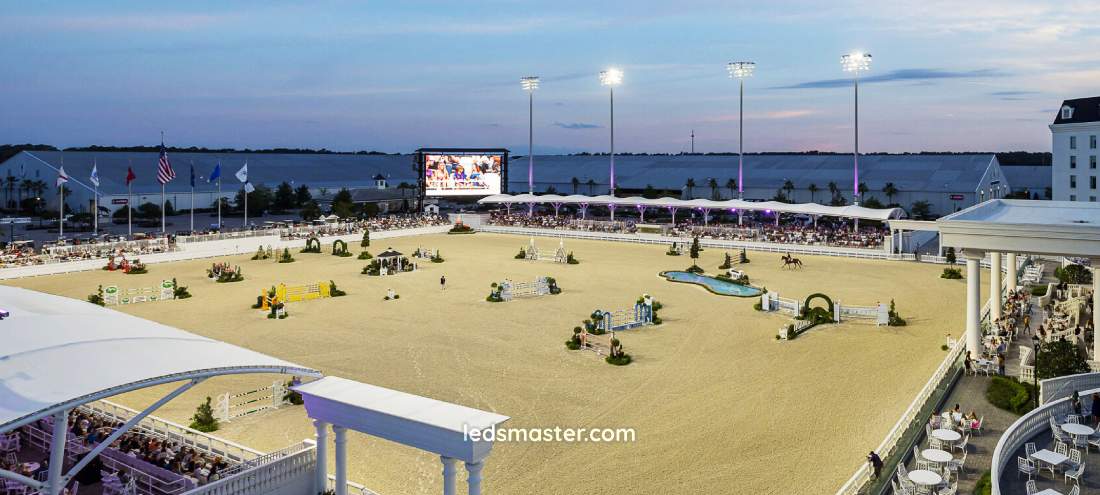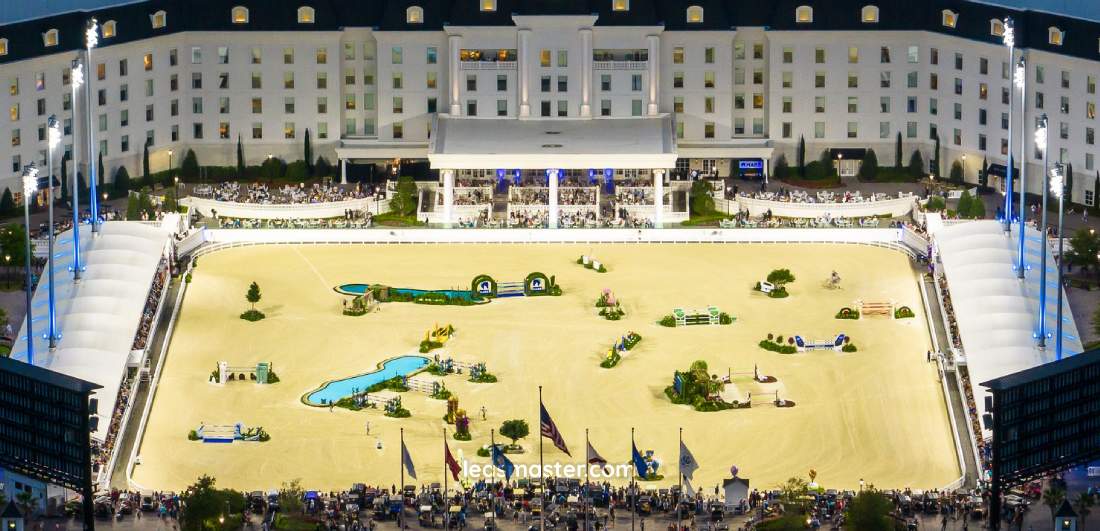Our equestrian arena lighting solutions are designed for high-performance activities, offering exceptional visibility with a high Color Rendering Index (CRI) crucial for competitions. Upgrade your arena with our premium lighting and experience unparalleled clarity and performance.
Whether for training, competition, or recreational riding, appropriate lighting ensures visibility, enhances performance, and contributes to the overall experience. This article delves into the essential aspects of equestrian arena lighting, including the importance of high Color Rendering Index (CRI) for competitions, the required lux levels, and other relevant considerations.
Get your complimentary lighting design today
Table of Contents
ToggleColor Rendering Index (CRI) measures a light source’s ability to accurately reveal the colors of various objects compared to a natural light source. For equestrian arenas, particularly those hosting competitions, high CRI lighting is essential. A CRI value of 80 or above is generally recommended, with 90 or above being ideal for high-stakes events.
High CRI lighting ensures that the colors of the horse, rider’s attire, and arena elements are rendered accurately. This is crucial for judges and spectators to make precise assessments and for photographers and videographers to capture true-to-life images. Moreover, horses themselves respond better to environments where colors are vivid and true, reducing stress and enhancing performance. Accurate color representation helps in maintaining the aesthetic appeal of the event and ensures that all participants can be seen clearly, making the competition fairer and more enjoyable for everyone involved.

The illuminance requirements for equestrian activities depend largely on the intensity of the task at hand. For training sessions, a lux level ranging from 150 to 200 is generally adequate. This range provides enough illumination for riders to engage in basic riding exercises and flat work while minimizing excessive glare and distracting shadows. Riders can focus on improving their skills without the strain caused by insufficient or overly harsh lighting.
In recreational arenas, where the atmosphere is more relaxed and casual riding takes place, a lux level of 200 to 300 is advisable. This enhanced level of brightness creates a comfortable environment for riders, ensuring that the arena is sufficiently lit for leisure activities. With a well-lit arena, riders can better enjoy their experience, allowing for improved interaction with their horses.
Conversely, professional competitions present unique challenges that demand higher lux levels to ensure clarity for judges, spectators, and participants. A minimum of 500 lux is often required for these events, with elite competitions calling for even greater illumination, typically ranging from 800 to 1000 lux. Such high levels of light are vital for clearly distinguishing every movement and detail, allowing judges to make accurate assessments and enhancing the overall experience for everyone involved.
Adequate lux levels serve multiple purposes, including the reduction of accidents through improved visibility and the minimization of eye strain for both horses and riders. Additionally, well-illuminated arenas provide a visually appealing environment, enhancing the aesthetic quality of the space. This is particularly significant during evening events or within indoor arenas where natural light is limited. A reliable lighting setup ensures that performance quality remains consistent, irrespective of the time of day or environmental conditions.
Ensuring adequate lux levels is a measure against accidents. Clear visibility is essential for both riders and horses, enabling them to navigate the arena with confidence. This safety aspect is particularly crucial during competitive events, where the stakes are higher, and accurate judgment of movements can affect performance outcomes.
Various types of fixtures are available, including LED lights, metal halide lamps, and high-pressure sodium lights. Each has its unique advantages and disadvantages, which must be carefully evaluated in the context of the specific arena requirements.
LED lights have become the preferred option for modern equestrian arenas due to their high efficiency and extended lifespan. They boast an excellent color rendering index (CRI), which is essential for accurately illuminating colors and details within the arena. LEDs are remarkably versatile, offering both focused and diffuse lighting options, making them suitable for different activities and settings. Their energy efficiency not only reduces operational costs but also minimizes environmental impact, aligning with a growing emphasis on sustainability in facility management.
One of the key advantages of LED lights is their ability to turn on instantly and be dimmed as needed, allowing for adaptability in dynamic environments such as equestrian arenas. This feature is particularly beneficial during events that may require varying levels of illumination, such as training sessions, clinics, or competitions. With LEDs, operators can easily adjust lighting conditions to suit the specific requirements of each activity.
Metal halide lamps, while not as efficient as LEDs, provide bright, white light with a decent CRI. They are still employed in some competition arenas due to their high intensity and broad coverage area. However, these lamps have a shorter lifespan than LEDs and require a longer warm-up time before reaching full brightness. Despite these drawbacks, they remain a popular choice for certain applications, particularly where high-intensity lighting is paramount.
High-pressure sodium lights are another option, although they are less commonly used in equestrian arenas. These lights produce a warm, yellowish light and have a lower CRI compared to LEDs and metal halide lamps. While they offer energy efficiency and a long lifespan, their color quality may not be suitable for environments where accurate color representation is essential. High-pressure sodium lights can still be viable in specific applications where the quality of light is less critical, such as in certain outdoor spaces.
Creating an effective lighting layout ensure uniform illumination across the entire arena. This not only eliminates dark spots but also reduces glare, enhancing the visual experience for both participants and spectators. Achieving uniform light distribution is fundamental, as it helps to prevent accidents by ensuring that all areas of the arena are adequately lit.
The height and positioning of lighting fixtures greatly influence the quality of illumination achieved within the arena. Proper mounting height is crucial; lights should be installed at a sufficient height to cover a wide area while minimizing shadows and glare. For outdoor arenas, lights are typically mounted at heights ranging from 20 to 30 feet. Indoor arenas may require slightly lower mounting heights, depending on the specific design and intended use of the space.
The angle and direction of lighting fixtures should be meticulously planned to focus light where it is needed most. Adjustable fixtures can provide the necessary flexibility to fine-tune the lighting, allowing operators to achieve optimal coverage and reduce glare effectively. By ensuring that light is evenly distributed throughout the arena, operators can create an environment that promotes safety and enhances the experience for both riders and spectators.
A well-designed lighting system enhance safety within the equestrian arena. Proper illumination allows riders to better perceive their surroundings, which reduces the likelihood of accidents and facilitates safer riding conditions. Clear visibility is vital for both horses and riders, enabling accurate judgment of movements and the identification of potential hazards.
In addition to safety, the aesthetic appeal of the arena can greatly influence the overall experience for riders and spectators. Thoughtful lighting design can highlight the natural beauty of the space, creating an inviting atmosphere that encourages participation and appreciation for equestrian activities. Effective lighting contributes to an engaging environment, making both training sessions and competitions more enjoyable for all involved.
The growing focus on sustainability and energy efficiency has led many equestrian facilities to evaluate their lighting options carefully. LED lights stand out in this regard, as they consume significantly less energy than traditional lighting fixtures. This reduction in energy usage not only translates to lower operational costs but also decreases the overall carbon footprint of the facility, aligning with modern sustainability goals.
The long lifespan of LED fixtures also minimizes the need for frequent replacements, reducing waste and contributing to a more sustainable operation. By opting for energy-efficient lighting solutions, equestrian facilities can demonstrate a commitment to environmental responsibility while providing the necessary illumination for safety and performance.
Advancements in lighting technology present new opportunities for optimizing equestrian arenas. Smart lighting systems enable automation and remote control of lighting levels, allowing operators to adjust illumination based on specific activities or environmental conditions. These systems can be programmed to provide varying lux levels depending on the requirements of different events or training sessions.
Integrating smart technology enhances convenience while also optimizing energy usage. By utilizing sensors and timers, facilities can ensure that lights are only activated when needed, further contributing to energy efficiency and sustainability. The ability to control lighting dynamically adds a layer of sophistication to arena management, providing enhanced user experience and operational efficiency.
Regular maintenance and upkeep of lighting systems ensure their longevity and optimal performance. Establishing a routine for scheduled inspections allows for early identification of potential issues, such as burnt-out bulbs or misaligned fixtures. Prompt repairs can prevent minor problems from escalating into more significant concerns that could disrupt operations.
Cleaning fixtures and lenses maintain maximum light output. Accumulated dust, dirt, and debris can diminish illumination levels, leading to inadequate lighting conditions that may affect safety. Developing a maintenance schedule that includes cleaning and inspection will help prolong the life of the lighting system while ensuring consistent performance.
In addition to routine maintenance, it is beneficial to provide training and education for staff responsible for managing the lighting systems. Ensuring that personnel understand the operation of lighting fixtures, smart technology, and maintenance procedures can significantly enhance the effectiveness of the lighting setup. Staff who are knowledgeable about the equipment can respond more efficiently to issues and make informed decisions regarding adjustments or repairs.
Equipping staff with the skills to manage lighting effectively contributes to a more professional atmosphere within the equestrian arena. This investment in training not only supports the safe operation of the facility but also fosters a culture of excellence and attentiveness to detail.
Examining successful case studies of equestrian arenas that have implemented effective lighting strategies can provide valuable insights and inspiration. One such example is the use of LED lighting in an outdoor jumping arena. By transitioning from traditional lighting to LED fixtures, the arena achieved significant improvements in illumination quality and energy efficiency. Riders and horses benefited from reduced glare and enhanced visibility, leading to improved performance and safety during competitions.
Another notable case involved the integration of smart lighting technology in a large indoor arena. The implementation of sensors and programmable controls allowed for dynamic adjustments to lux levels based on the time of day and the specific activities taking place. This flexibility resulted in better energy management and a more adaptable environment that catered to diverse equestrian events.

Beyond CRI and lux levels, there are several other factors to consider when planning equestrian arena lighting. Glare can be a significant issue in equestrian arenas, affecting both riders and horses. Anti-glare lighting fixtures and proper positioning can help mitigate this problem, ensuring a comfortable and safe environment. Glare reduction is especially important in competitions where precision and clarity are paramount.
For outdoor arenas, lighting fixtures must be weather-resistant. This includes protection against rain, wind, dust, and temperature fluctuations. Durable, weatherproof fixtures ensure longevity and consistent performance. Weather resistance is essential to maintain the integrity of the lighting system and ensure safety during various weather conditions.
Given the large area and high lux requirements, energy efficiency is a consideration. LED lights are particularly advantageous in this regard, offering significant energy savings compared to traditional lighting options. Energy-efficient lighting reduces operational costs and minimizes the environmental footprint of the arena, making it a sustainable choice for long-term use.
Equestrian arena lighting is a complex but aspect of creating a safe and effective environment for both training and competition. High CRI lighting ensures accurate color representation, while appropriate lux levels provide sufficient illumination for various activities. The choice of lighting fixtures and the design of the lighting layout play crucial roles in achieving optimal performance. By considering factors such as glare reduction, weather resistance, and energy efficiency, arena owners can create a well-lit, safe, and enjoyable space for all equestrian activities.